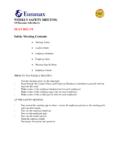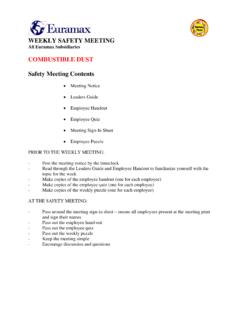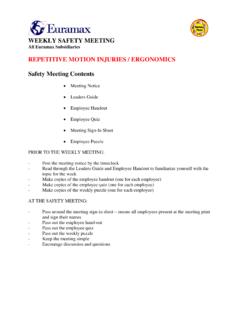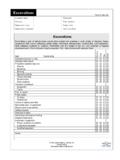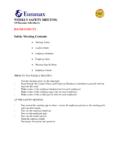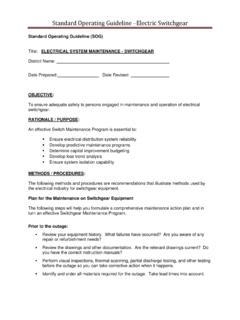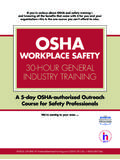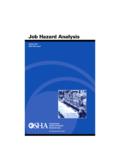Transcription of WEEKLY SAFETY MEETING LOCKOUT / TAGOUT …
1 WEEKLY SAFETY MEETING All Euramax Subsidiaries LOCKOUT / TAGOUT SAFETY MEETING Contents MEETING Notice Leaders Guide Employee Handout Employee Quiz MEETING Sign-In Sheet Employee Puzzle PRIOR TO THE WEEKLY MEETING : - Post the MEETING notice by the timeclock - Read through the Leaders Guide and Employee Handout to familiarize yourself with the topic for the week - Make copies of the employee handout (one for each employee) - Make copies of the employee quiz (one for each employee) - Make copies of the WEEKLY puzzle (one for each employee) AT THE SAFETY MEETING : - Pass around the MEETING sign-in sheet ensure all employees present at the MEETING print and sign their names - Pass out the employee hand-out - Pass out the employee quiz - Pass out the WEEKLY puzzle - Keep the MEETING simple - Encourage discussion and questions WEEKLY SAFETY MEETING NOTICE THIS WEEK, OUR SAFETY MEETING WILL COVER LOCKOUT / TAGOUT TIME: _____ DATE: _____ PLACE: _____ WEEKLY SAFETY MEETING All Euramax Subsidiaries Leaders Guide Page 1 LOCKOUT / TAGOUT EURAMAX PROCEDURE REFERENCE: : LOCKOUT / TAGOUT Program MEETING OBJECTIVE.
2 OSHA requires each Euramax facility to have an energy control program, designed to prevent unexpected start-up of machinery and equipment, or the unintentional release of stored energy. The purpose of this MEETING is to review your energy control program with your employees and to make sure they are fully aware of all the SAFETY rules concerning LOCKOUT / TAGOUT of machinery and equipment. MEETING PREPARATION: Read the Euramax procedure, understand the contents, and ensure compliance. Gather the locks and tags used in the procedure and review their proper use. Prepare tags to show the correct way to fill them out. Make sure locks and LOCKOUT devices are in working order. An actual demonstration of LOCKOUT / TAGOUT procedures on a piece of equipment would be the most effective way to teach the procedures.
3 If you decide to do this, be sure to make the necessary arrangements well ahead of time in the area where the equipment is located. Review the employee handout to see if there are any other materials you wish to bring to the MEETING . Use a flip chart during the discussion to write key points and employee responses. This technique visually reinforces your instruction. MATERIALS CHECKLIST: Samples of LOCKOUT / TAGOUT devices Flip chart and marking pens MEETINGINTRODUCTION Today we are going to talk about out Energy Control Program, also known as LOCKOUT / TAGOUT . The goal of this SAFETY program is to prevent the unexpected start-up of machinery and equipment, or the unintentional release of stored energy.
4 Either one could kill or severely injure someone when the equipment is being repaired, serviced, or maintained. We ll cover the basic information you need to know to protect yourself and your co-workers from this type of accident. What you learn here today could save a life tomorrow. WEEKLY SAFETY MEETING All Euramax Subsidiaries Leaders Guide Page 2 LOCKOUT / TAGOUT OSHA estimates that following LOCKOUT / TAGOUT procedures saves 28,400 lost workday injuries and 31,900 non-lost-workday injuries each year. That s why all employees whether they re authorized to repair and service equipment, work on equipment, or just work in an area with equipment need to be familiar with the basics of LOCKOUT / TAGOUT and the energy control process.
5 Question: What is the purpose of LOCKOUT / TAGOUT procedures? Answer: To prevent the unexpected start-up of moving parts or release of stored energy that could cause injury or even death. Question: OSHA s LOCKOUT / TAGOUT standard is actually called the Control of Hazardous Energy Standard. How would you define hazardous energy ? Answer: Hazardous energy is stored energy that could cause injury to employees while they are repairing, servicing, or maintaining equipment. Question: What kinds of energy can be hazardous? Answer: All types of energy can be hazardous if they aren t controlled. For Electrical energy Mechanical energy Chemical energy ( , a gas or liquid chemical) Hydraulic energy ( , pressurized fluid) Pneumatic energy ( , compresses air) Thermal energy ( , steam) Question: An employee who services or maintains machinery and equipment must know what all of the energy sources are for that piece of equipment.
6 Why does having this knowledge play an essential role in ensuring proper LOCKOUT / TAGOUT ? Answer: A single piece of machinery or equipment may be powered by more than one type of energy. There can be both direct and hidden sources of energy. Proper LOCKOUT / TAGOUT Controlling and isolating all of the equipment s sources of energy Releasing any stored energy so that the machine is at zero state of energy WEEKLY SAFETY MEETING All Euramax Subsidiaries Leaders Guide Page 3 LOCKOUT / TAGOUT Question: LOCKOUT / TAGOUT procedures apply during the routine service and maintenance of machinery and equipment (and during production if any servicing activity takes place then).
7 What work tasks are considered servicing or maintenance activities? Answer: Installation, set-up, adjustment, repairs, inspections, modifications, cleaning, lubrication, unjamming and changing tools. Question: What are the basic purposes of locks and tags? Answer: Locks are used to block the flow of energy from a power source to the machinery or equipment. Tags are warnings to anyone passing through the work area not to turn the power on. Question: Where is a lock usually placed? Answer: Locks and LOCKOUT devices are typically placed on an energy-isolating device, such as a circuit breaker, shut-off switch, or valve. This physically prevents the unexpected start-up of machinery or the release of stored energy while the machine is being serviced or maintained.
8 Show samples of the types of locks and LOCKOUT devices used by your facility and discuss their proper placement. Question: What is TAGOUT and what is its purpose? Answer: TAGOUT means putting a label or tag on the energy-isolating device to warn other employees that the equipment or machine must not be operated. Show one of your facility s tags. Question: What are examples of the types of warnings that might be included on tags. Answer: Do not open. Do not start. Do not energize. Do not operate. WEEKLY SAFETY MEETING All Euramax Subsidiaries Leaders Guide Page 4 LOCKOUT / TAGOUT Question: Is it ever appropriate to use tags by themselves? Answer: The best means of protection is to use both locks and tags. However, because it may be physically impossible to lock out certain pieces of equipment, a tag may be used by itself in such situations.
9 But remember that although tags can notify other employees about possible dangers they are not as effective as LOCKOUT devices. Question: According to OSHA s LOCKOUT / TAGOUT standard, workers are either authorized employees or affected employees. How does the standard define authorized employees and what are their responsibilities? Answer: Authorized employees are those who service or maintain machines and equipment and are actually authorized to use locks and tags. They need to know when LOCKOUT / TAGOUT must performed, the exact procedures for conducting LOCKOUT / TAGOUT , and the proper steps for safely restarting equipment and machinery after service or maintenance has been completed.
10 Tell employees that they should never attempt to repair, service, or maintain equipment on machinery unless they have been authorized and trained. Designate which employees in the department are authorized and trained to repair, service, or maintain equipment. Question: How does the standard define affected employee ? Answer: Affected employees are workers who operate or use equipment that may be locked and tagged out. Workers whose job requires them to work in areas that contain machinery or equipment that may be locked and tagged out are also considered affected employees. Question: Since affected employees don t actually have to perform LOCKOUT / TAGOUT procedures, why do they have to understand all steps?

